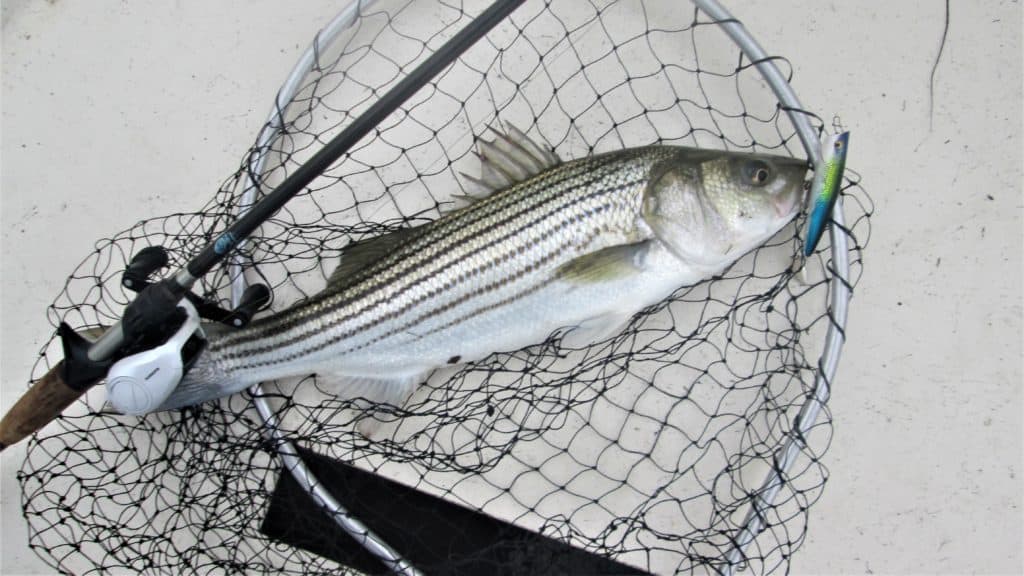Sporting Life

Time for Topwater Techniques and Tribulations
By Dennis Doyle
Casting a ¾-ounce surface plug arcing some hundred feet to the edge of a submerged jetty, I immediately put the small casting reel into gear as the lure touched down and gave it a small twitch. The first few seconds are often the most productive part of the cast. Some initial plug movement upon landing sends a signal to any nearby alert rockfish that the object is alive and possibly beginning to flee.
In this instance nothing happened, not an uncommon occurrence. But still, I paused. There’s a second general rule on surface retrieval technique: wait until the ripples from the lure’s landing subside before you begin.
A long pause later, I finally began to swim my plug back and within a few feet a finned brute exploded out of the water, sending violent geysers skyward. Luckily, I hesitated again—nerve control is also essential in successful topwater angling. Staring at the disturbed froth in the first seconds of the aftermath with no tension on my line, I spied my glittering popper rocking gently all alone at the edge of the torn water.
The primary failure in hooking a surface-striking bass is to strike at the explosion of a fish’s attack. It is difficult to resist reacting to the blow-up. Every nerve in your body is screaming “fish on” when water is flung skyward by an angry predator intent on murder. But all too often the attack does not result in a hookup.
There are a lot of reasons for this, the first being that the fish, in its eagerness, simply misses the lure. It is, after all, in a hungry rush. Generally, only about half of surface strikes result in immediate hookups. The other half, called blow-ups, are an explosion of water but no fish. That’s where superior nerve control comes in. This is just the beginning—stay tensed to strike but make no move except to insure there is no slack in your line.
The fish may have also missed the hook because it struck with the side of its head or its tail to stun the bait and didn’t engulf it. In most cases the predator is still somewhere nearby and eyeing its (presumably) injured prey. Count to about five, then twitch the bait again as if the critter is coming back to consciousness. That usually does it. If it doesn’t, emulate the slow movements of a crippled bait that is struggling to escape.
In this case, the former tactic did the trick. The rockfish finally and enthusiastically engulfed the bait. I set the hook and the battle was on. Surface strikes with plugs are quite dramatic as the hooked striper often believes the plug is the attacker and rockets out of the water, trying to flee the offending object as quickly as possible. Since the fish does all of this on and above the surface and in plain sight in incredibly acrobatic moves, it is quite an exciting display.
And since this usually also occurs in shallow water, when the fish finally realizes that it’s actually tethered to something else, it then attempts to vacate the premises at highest speeds possible. Which is why working a surface plug is the most exciting style of fishing of them all.
Now is the time to get some.
*****
Fishfinder:
Rockfish season is back on and early reports are excellent. The quiet period of the last few weeks has relaxed and reinvigorated the schools of rockfish, and while the bulk of the mid-Bay fish remain well to the north of the Bridge there are scattered pods of legal-sized fish working bait all around tributary mouths. Early and late angling for the surface bite is starting up and the cooler nights are making the shallows comfortable for cruising rockfish, especially in the mornings. Bomber Badonk a Donks, Stillwater Smack Its and Mirrorlure Top Dogs are the best producers but any surface plug worked thoughtfully should produce action for the determined angler. The one true rule is early and late. And if the topwater is not producing, a soft plastic paddletail, or chatterbait jig worked over the same areas just might do the trick. After mornings try jigging 2-ounce, 7-inch, chartreuse soft plastics over marked fish down deep. Trolling anglers are finding rockfish as well, dragging medium to small sized bucktails tipped with Sassy Shads in white and chartreuse. Spanish mackerel have also shown up, making the trolling game that much more exciting. The macks love shiny baits dragged at higher speeds, six knots or more rather than five and below for rock. A casting rod tipped with a Kastmaster will also do the job if you see them breaking on bait. It’s the beginning of the fall bite and will only get better the next few months. Crabbing remains disappointing but the jimmies remain delicious.
